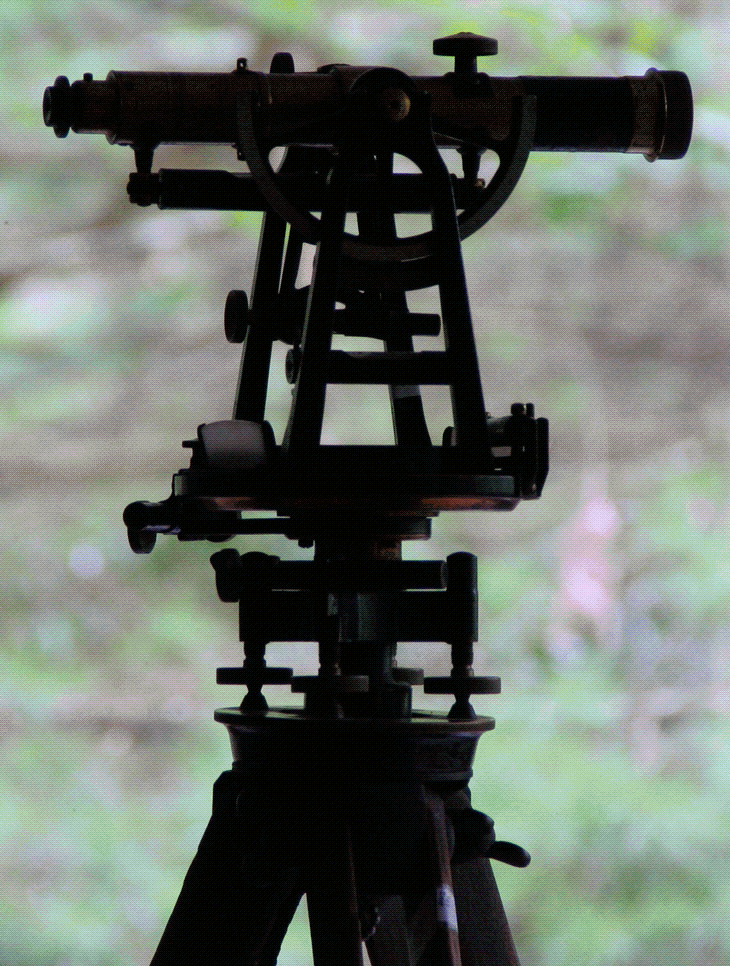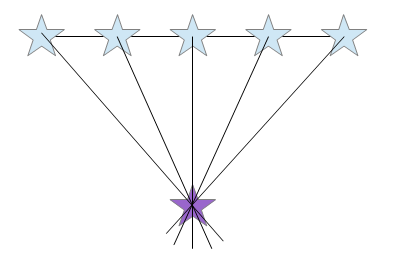HOME > >
MAP MAKING MAIN PAGE
Map Making- Theodolite: The Tool of the Trade
A theodolite is the instrument you use to measure the angles you need to make maps from angles. You put the theodolite at the apex of an angle, and use something to "point" to a distant object which is on one of the arms of the angle. You read a number off of the theodolite. You then swing the "something" to point to a second distant object, this time something on the other arm of the angle you want to measure. And read another number off of the instrument. The difference between the two numbers tells you the size of the angle, not necessarily in degrees. (Although, of course, I doubt that any commercially available theodolite would be calibrated in any other unit.)
I enjoyed a quest for the perfect 'home built' theodolite for over 20 years. If you think you can design the best possible answer in 20 minutes, good luck to you. If you read all of what follows right now, you're going to miss some of the fun I've had on my quest. (Don't worry... this essay is something of a dance of veils... it gives things away progressively, and warns you beforehand.)
My current theodolite, excluding the camera tripod on which it is mounted, cost me about $30. It can measure angles to fractions of a degree. (The photo is of someone else's theodolite!)
Beware- the word, I believe!- is "theodolite". The lysdexics among g us, judging from a Google search, sometimes make that "theolodite".
-----------
As you think about how you would build a theodolite, think about measuring devices in general. If you are organizing this as a school activity, you might want to do it as a challenge along the following lines:
Set up five angle measuring exercises for the class. Get each participant to measure each angle. Discard any "simply wrong" measurements. Average the remainder. Now score the participants on how little their readings vary from the class's average.
An alternative test for your theodolite is to go to a large field. Along one edge, mark 5 (or more) locations all in a straight line, each perhaps 50 feet from its neighbors. The line the poles are on is "the baseline". Use a greater separation, if you can measure the intervals accurately, and space allows. You don't need to know how large the interval is, but all of the intervals must be the same. Make sure that they are in line with one another by looking along the line.
About 150 feet from the baseline, at a point roughly perpendicular to it's middle, stick a pole in the ground. Now, from each of the five locations along the baseline, measure the angles between the baseline and the line towards the pole not on the baseline.
Next, prepare a map of what you measured. Start by drawing a line on a piece of paper. Mark 5 evenly spaced points along it. Draw the angles you recorded. The lines going away from the baseline will all meet at one point if your readings (and drawing!) were accurate.
Critical elements
Basic: Any measuring device must be able to return the same reading every time it measures the same angle, weight, length, etc. It must give the answer in usable units.
With the theodolite, a major element in achieving success will be your skill in devising something that will allow you to point directly at the distant objects which define the direction of the two arms of the angle.
How you read off how far around your pointer has swung will be another critical area.
When you are thinking about the design, remember that the simpler you can make it, the less chance there will be for inaccuracies to creep in. Attack the problem from both ends: What do I want to make? What can I (easily) make?
*** Click here to go on to my answer to the challenge of making a usable theodolite without unreasonable expense ***
Click here to go to the map making topic's first page
Click here to go to the site's main page
Search across all my sites with the Google search button at the top of the page the link will take you to.
Or...
Search just this site without using forms,
Or... again to search just this site, use...
The search engine merely looks for the words you type, so....
*! Spell them properly !*
Don't bother with "How do I get rich?" That will merely return pages with "how", "do", "I", "get" and "rich".
I have other sites. My Google custom search button will include things from them....
One of my SheepdogGuides pages.
My site at Arunet.
Ad from page's editor: Yes.. I do enjoy compiling these things for you... I hope they are helpful. However.. this doesn't pay my bills!!! If you find this stuff useful, (and you run an MS-DOS or Windows PC) please visit my freeware and shareware page, download something, and circulate it for me? Links on your page to this page would also be appreciated!
--Click here to visit editor's freeware, shareware page.--
This page's editor, Tom Boyd, will be pleased if you get in touch by email.
 Page has been tested for compliance with INDUSTRY (not MS-only) standards, using the free, publicly accessible validator at validator.w3.org. Mostly passes.
Page has been tested for compliance with INDUSTRY (not MS-only) standards, using the free, publicly accessible validator at validator.w3.org. Mostly passes.
AND passes...

-- Page ends --


